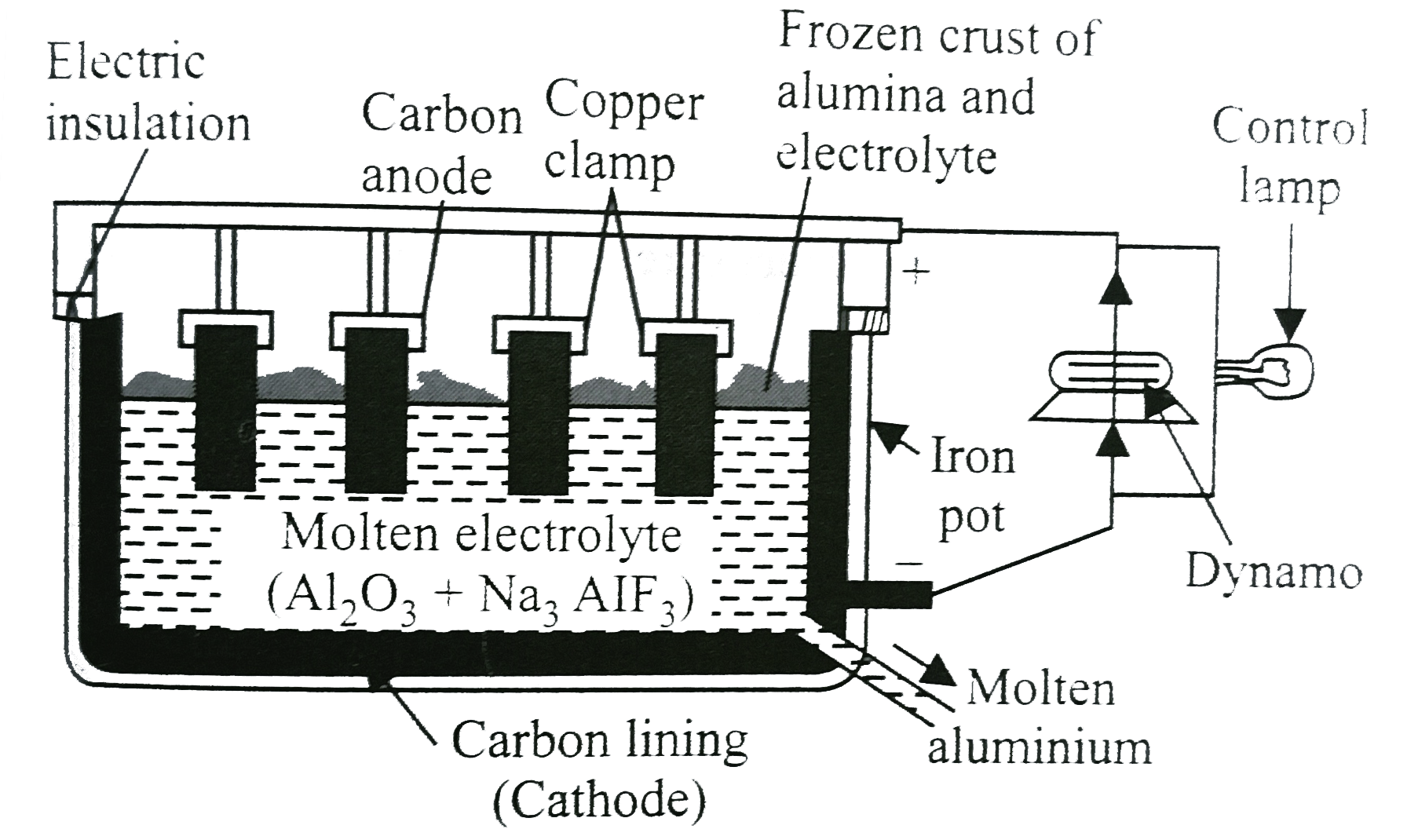Consider the following isolation//purification processes.
(I) Heating impure metal with I2 at 150−200∘C and passing the resulting volatile iodide on hot tungsten filament at 1400∘C to get the pure metal.
(II) Heating the sulphide ore in air until a part is converted to oxide and then further heating in the absence of air to let the oxide react with unchanged metal sulphide to get the metal.
(III) Electroysis of the molten electrolyte containing metal oxide and cryolite of fluorspar to obtain the metal.
The processes used for obtaining aluminium, titanium and lead are respectively:
(I),(II) and (III)
(II),(III) and (I)
(III),(I)and (II)
(II),(I)and (III)
The correct Answer is:C
(I) Ti(s)(impure)+2I2(g)50−250∘C−−−−−−→TiI4(volatile)
1400∘C−−−−−−−−−−→Tunghten filamentTi(s)(pure)+2I2(g)
(II) 2PbS+3O2Δ−−→2PbO+2SO2
PbS+2PbOhigh−−→temp3Pb+SO2
(III) cathode: A13(melt)+3e−→A1(1)
Anode: C(s)+O2−(melt)→CO(g)+2e−2
C(s)+2O2−(melt)→CO2(g)+4e−

Topper's Solved these Questions
- BOOK - A2ZCHAPTER - GENERAL PRINCIPLES AND PROCESS OF ISOLATION OF METALSEXERCISE - Metallurgy Of Cu, Fe, Ag, Al, Zn, And Au97videos
GENERAL PRINCIPLES AND PROCESS OF ISOLATION OF METALS
- BOOK - A2ZCHAPTER - GENERAL PRINCIPLES AND PROCESS OF ISOLATION OF METALSEXERCISE - Section B - Assertion Reasoning17videos
GENERAL PRINCIPLES AND PROCESS OF ISOLATION OF METALS
- BOOK - A2ZCHAPTER - ELECTROCHEMISTRYEXERCISE - Section D - Chapter End Test30videos
ELECTROCHEMISTRY
- BOOK - A2ZCHAPTER - MOCK TESTEXERCISE - Mock Test 245videos
MOCK TEST
Similar Questions
Knowledge Check
- Question 1 - Select One
Consider the following isolatin/purification pocess:
(P) Heating impure metal with I2at150−200∘C and passing the resulting volatile iodidle on hot tungsten filament at 1400∘C to get the pure metal.
(Q) Heating the sulphide ore in air unitil a part is converted to oxide and then further heating in the absence of air to let the oxide react with unchanged metal sulphide to get the metal.
(R) Electrolysis of the molten electrolyte containing metal oxide and cryolite or flourspar to obtain the metal
The process used for obtaining aluminium, titanium and lead are respectively,AP,Q and R onlyBQ,R and PCR,P and QDQ,P and R - Question 2 - Select One
Consider the following metallurgical processes:
(I) Heating impure metal with CO and distilling the resulting volatile carbonyl (b.p.43∘C) and finally decomposition at 150∘−200∘C to get the pure metal.
(II) Heating the sulphide ore in air until a part is converted to oxide and then further heating in the absence of air to let the oxide react with unchanged metal sulphide.
(III) Electrolysis of the molten electrolyte containing approximately equal amounts of the metal chloride and NaCl to obtain the metal.
The processes used for obtaining magnesium , nickel and copper are respectively.A(I),(II) and (III)B(II),(III) and (I)C(III),(I) and (II)D(II),(I) and (III) - Question 3 - Select One
Consider the following metallurgical processes:
(I) Heating impure metal with CO and distilling the resulting volatile carbonyl (b.p.43∘C) and finally decomposition at 150∘−200∘C to get the pure metal.
(II) Heating the sulphide ore in air until a part is converted to oxide and then further heating in the absence of air to let the oxide react with unchanged metal sulphide.
(III) Electrolysis of the molten electrolyte containing approximately equal amounts of the metal chloride and NaCl to obtain the metal.
The processes used for obtaining magnesium , nickel and copper are respectively.A(I),(II) and (III)B(II), (III) and (I)C(III), (I) and (II)D(II), (I) and (III)
Consider the following metallurgical process:
(P) Heating impure metal with CO and distilling the resulting volatile cabonyl (b.p.43∘C) and finally decomposing at 150∘−200∘C to get the pure metal.
(Q) Heating the sulphide ore in air unitl a part is converted to oxide and then further heating in the absence of air to let the oxide react, with unchanged metal sulphide.
(R) Electrolysis of the molten electrolyte containing approximately equal amounts of the metal chloride and NaCl to obtian the metal
The processes used for obtaining manesium nickel and copper are respectively:View SolutionConsider the following metallurgical processes :
(1) Heating impure metal with CO and distilling the resulting volatile carbonyl (BP43∘C) and finally decomposing at 150∘C to 230∘C to get pure metal.
(2) Heating the sulphide ore in air until a part is converted to oxide and then further heating in the absence of air to let the oxide react with unchanged sulphide.
(3) Electrolysing the molten electrolyte containing CaCl2 to obtain the metal
The processes used for obtaining sodium, nickel, and copper are, respectivelyView SolutionNitrate is converted into metal oxide on heating. This metal is:
View SolutionA process of heating the ore in absence of air is called
View SolutionSulphide ores are converted into oxides by
View Solution


